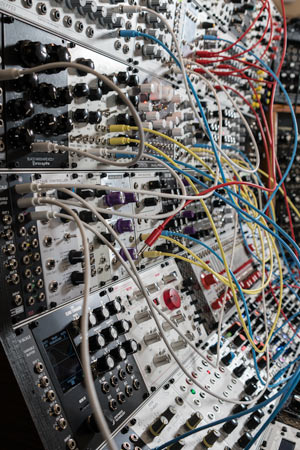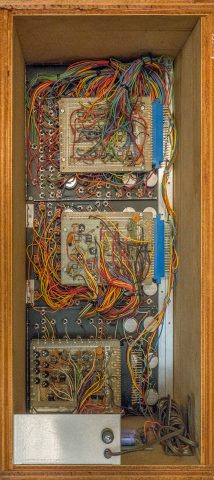Most of the posts on this site are devoted to smaller modular systems I build for my courses, such as the Learning Modular Synthesis or Eurorack Expansion racks. However, I recently did a 2-hour live webcast with “DivKid” Ben Wilson and nearly 600 of our closest friends on YouTube about my personal system, and many of the choices that went into building it. Here is that video, followed by some background:
Click here to view my system on ModularGrid as of that webcast.
The main goal has been to have a variety of modules rather than two or three of a kind, so I can play with a wide range of sounds. The secondary goal is to be able to play & sequence up to four full voices at once. It is housed in an ADDAC Monster Frame with an upgraded power supply.
I like to group my modules by function, so I know generally where to reach rather having to remember where a specific module is. I’m also focused on signal flow: left to right for VCOs to VCAs; modulation flows up to them from underneath. Here is how the system is arranged overall:
- sequencing and percussion are along top
- VCOs and wave modifiers are in the middle left
- VCFs and VCAs are in the middle right
- mixers are in the center
- modulation sources (LFOs and envelopes) run under the VCOs/VCFs/VCAs
- the bottom row is input & output, with effects
Inside these major sections are further divisions. For example:
Sequencing & Percussion: In the “sequencing and percussion” section along the top, the sequencers are on the left, clock generation and logic modules are in the center, and percussion modules – including a noise source, dual LPG, and a stereo submixer – are on the right. I’d like to get more of the quantizers (possibly including the Ornament & Crime) back near the sequencers, but they got squeezed out; most are currently closer to the modulation & input sections.
VCOs & Wave Modifiers: The VCOs are arranged with the analog ones on top and digital or unusual ones (such as the Verbos Harmonic Oscillator) on the bottom, with the waveshapers in between. Buffered mults (a Frap Tools 333 and a set of AJH Synth V-Scales) plus a precision adder (a rare Analogue Systems RS-420 Octave Controller) are to the left of the VCOs.
Mixer Section: The audio mixers are in the middle so the VCOs can be easily combined before going off to the filter section. There are a variety of mixers for different sounds, from the clean Low-Gain Submix to the classic Moog CP3-like .mix from STG Soundlabs. I also added to this section a voltage-controlled crossfader and even a Steiner filter clone that has independent inputs for each of the filter modes so I can perform frequency-dependent layering and crossfading.
VCFs, VCAs, & LPGs: In the VCF/VCA section, the “normal” filters are above, the resonators and formant filters are below, with the LPGs and VCAs in between. (You can see the continuation of a “collasping to the middle” motif here, just like with the VCOs and waveshapers.) To the right of my Eurorack VCAs is a vintage custom Gentle Electric cabinet with another dozen 3080-based Aries-like VCAs as well numerous other utilities such as mixers (it’s hand-wired back is shown to the right).
Modulation & Utilities: The modulation section underneath the VCO/VCF/VCA block has mostly LFO and random sources to the left, envelopes to the right, and in the center an additional CV mixer as well as a set of 4 Expert Sleepers Distings for utility functions.
Input: The keyboard/CV section is on the bottom left, anchored by an Expert Sleepers FH-1 plus two expanders, kept company by a Mutable Instruments Ears for analog gestures. A WMD Arpitecht along with another quantizer are next to that.
Output: In the middle bottom row are effects, and the bottom right contains a hole for a voltage-controlled mixer (probably a Xaoc Devices Praga) as well as analog & digital output modules plus a Xaoc Sewastopol for effects loops or an input from the studio’s mixer
The Future
This is the 9th layout of this case since I first got it just a year and a half ago, so I’m not shy about re-arranging things as I learn more about what’s most practical from a signal flow perspective, and also trading out modules to refine who is filling in specific rolls in the case.
There are holes for a few planned additions, including a Five12 Vector Sequencer, the aforementioned Praga mixer, and a trio of new AJH modules including their new dual SEM filter (replacing my current Doepfer A-106-5 SEM, which I otherwise love), 12-stage phaser (replacing my current Roland 578 pahse + chorus), and output “finalizer” module (EQ, enhancement, and reverb). Also, as a result of preparing for the aforementioned webcast I figured out I was missing a logic inverter and a Mordax DATA dedicated to my personal system (I already one in my video training rack); both have been ordered.
Indeed, my system is constanly evolving; here is the ModularGrid link for my system in its current state – I’ll try to keep it up as things change. Hope you find this info as well as the video above helpful for planning out your own modular sound garden!



